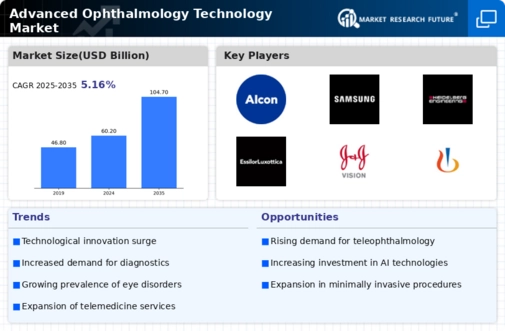Market Growth Projections
The Global Advanced Ophthalmology Technology Market Industry is projected to experience substantial growth in the coming years. With a market value of 60.2 USD Billion in 2024, it is expected to reach 104.7 USD Billion by 2035. This growth trajectory indicates a compound annual growth rate (CAGR) of 5.16% from 2025 to 2035. The increasing prevalence of eye disorders, coupled with technological advancements and rising healthcare expenditure, are key factors driving this growth. As the market evolves, it is likely that new players will enter the field, further intensifying competition and innovation within the industry.
Growing Awareness and Education
Growing awareness and education regarding eye health significantly influence the Global Advanced Ophthalmology Technology Market Industry. Public health campaigns and educational initiatives are increasingly emphasizing the importance of regular eye examinations and early detection of eye diseases. This heightened awareness encourages individuals to seek medical attention sooner, leading to increased demand for advanced ophthalmic technologies. Moreover, healthcare professionals are being trained in the latest technologies and treatment modalities, ensuring that they are equipped to provide optimal care. As awareness continues to rise, it is likely that more patients will utilize advanced technologies, thereby driving market growth and improving overall eye health outcomes.
Increasing Healthcare Expenditure
The Global Advanced Ophthalmology Technology Market Industry is benefiting from rising healthcare expenditure across various regions. Governments and private sectors are allocating more resources to healthcare, particularly in the field of ophthalmology. This increase in funding facilitates the adoption of advanced technologies and treatments, which are essential for addressing the growing burden of eye diseases. For example, countries with robust healthcare systems are investing in state-of-the-art surgical equipment and diagnostic tools, thereby enhancing patient access to quality eye care. As healthcare budgets expand, the market is projected to reach 104.7 USD Billion by 2035, reflecting the positive correlation between healthcare investment and technological advancement in ophthalmology.
Rising Prevalence of Eye Disorders
The Global Advanced Ophthalmology Technology Market Industry is experiencing growth due to the increasing prevalence of eye disorders such as cataracts, glaucoma, and age-related macular degeneration. According to health statistics, millions of individuals worldwide are affected by these conditions, leading to a heightened demand for advanced diagnostic and therapeutic technologies. The rise in the aging population, particularly in developed nations, further exacerbates this issue. As a result, healthcare providers are increasingly investing in innovative ophthalmic technologies to enhance patient outcomes and improve the quality of care. This trend is expected to contribute to the market's expansion, with projections indicating a market value of 60.2 USD Billion in 2024.
Emerging Markets and Global Expansion
Emerging markets are becoming increasingly important in the Global Advanced Ophthalmology Technology Market Industry. Countries in Asia-Pacific, Latin America, and Africa are witnessing rapid economic growth, leading to improved healthcare infrastructure and increased access to advanced ophthalmic technologies. As these regions develop, there is a growing demand for innovative eye care solutions to address the rising incidence of eye disorders. Companies are strategically expanding their operations into these markets, recognizing the potential for growth. This trend is expected to contribute to the overall market expansion, as investments in healthcare technology continue to rise in these developing regions.
Technological Advancements in Ophthalmology
Technological advancements play a pivotal role in driving the Global Advanced Ophthalmology Technology Market Industry. Innovations such as optical coherence tomography, laser-assisted surgeries, and artificial intelligence in diagnostics are transforming the landscape of eye care. These technologies not only improve the accuracy of diagnoses but also enhance the effectiveness of treatments. For instance, the integration of AI algorithms in imaging systems allows for earlier detection of diseases, which is crucial for successful interventions. As these technologies continue to evolve, they are likely to attract significant investments, further propelling market growth. The anticipated CAGR of 5.16% from 2025 to 2035 underscores the potential for continued advancements in this sector.



















Leave a Comment